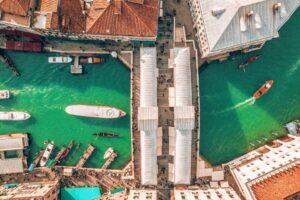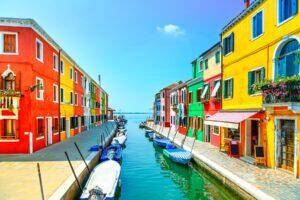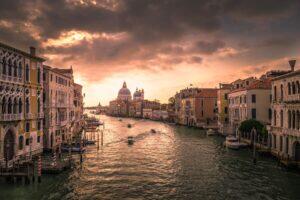Fodor's Expert Review Palazzo Ducale
Rising grandly above Piazzetta San Marco, this Gothic fantasia of pink-and-white marble is a majestic expression of Venetian prosperity and power. Although the site was the doges' residence from the 10th century, the building began to take its present form around 1340; what you see now is essentially a product of the first half of the 15th century. It served not only as a residence, but also as the central administrative center of the Venetian Republic.
Unlike other medieval seats of authority, the Palazzo Ducale is free of any military defenses—a sign of the Republic's self-confidence. The position of the loggias below instead of above the retaining wall, and the use of pink marble to emphasize the decorative function of that wall, gave the palazzo a light and airy aspect, one that could impress visitors—and even intimidate them, through opulence and grace rather than fortresslike bulk. You'll find yourself in an immense courtyard that holds some of the first evidence of... READ MORE
Rising grandly above Piazzetta San Marco, this Gothic fantasia of pink-and-white marble is a majestic expression of Venetian prosperity and power. Although the site was the doges' residence from the 10th century, the building began to take its present form around 1340; what you see now is essentially a product of the first half of the 15th century. It served not only as a residence, but also as the central administrative center of the Venetian Republic.
Unlike other medieval seats of authority, the Palazzo Ducale is free of any military defenses—a sign of the Republic's self-confidence. The position of the loggias below instead of above the retaining wall, and the use of pink marble to emphasize the decorative function of that wall, gave the palazzo a light and airy aspect, one that could impress visitors—and even intimidate them, through opulence and grace rather than fortresslike bulk. You'll find yourself in an immense courtyard that holds some of the first evidence of Renaissance architecture in Venice, such as Antonio Rizzo's Scala dei Giganti (Stairway of the Giants), erected between 1483 and 1491, directly ahead, guarded by Sansovino's huge statues of Mars and Neptune, added in 1567. Though ordinary mortals must use the central interior staircase, its upper flight is the lavishly gilded Scala d'Oro (Golden Staircase), also designed by Sansovino, in 1555.
The palace's sumptuous chambers have walls and ceilings covered with works by Venice's greatest artists. Visit the Anticollegio, a waiting room outside the Collegio's chamber, where you can see The Rape of Europa by Veronese and Tintoretto's Bacchus and Ariadne Crowned by Venus. The ceiling of the Sala del Senato (Senate Chamber), featuring The Triumph of Venice by Tintoretto, is magnificent, but it's dwarfed by his masterpiece, Paradise, in the Sala del Maggiore Consiglio (Great Council Hall). A vast work commissioned for a vast hall, this dark, dynamic piece is the world's largest oil painting (23 feet by 75 feet). The room's carved gilt ceiling is breathtaking, especially with Veronese's majestic Apotheosis of Venice filling one of the center panels.
A narrow canal separates the palace's east side from the cramped cell blocks of the Prigioni Nuove (New Prisons). High above the water arches the enclosed marble Ponte dei Sospiri (Bridge of Sighs), which earned its name in the 19th century, from Lord Byron's Childe Harold's Pilgrimage. Reserve your spot for the palazzo's popular Secret Itineraries tour well in advance. You'll visit the doge's private apartments and wind through hidden passageways to the interrogation (read: torture) chambers and the rooftop piombi (lead) prison, named for its lead roofing. Venetian-born writer and libertine Giacomo Casanova (1725–98), along with an accomplice, managed to escape from the piombi in 1756; they were the only men ever to do so.
READ LESS








